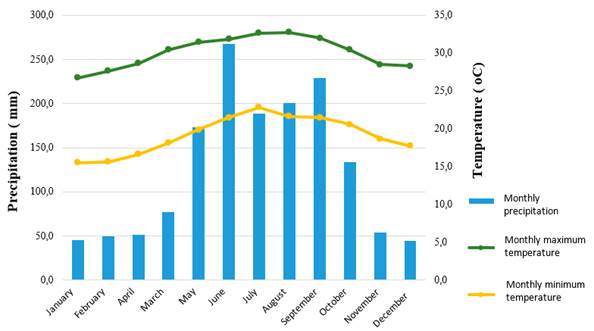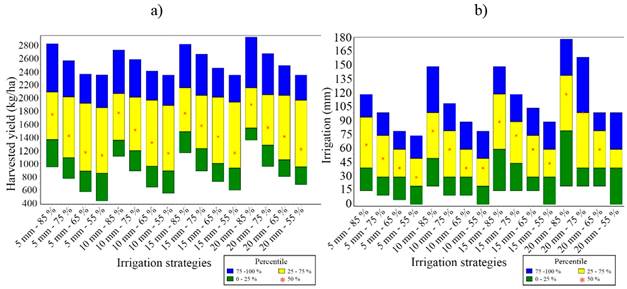Introduction
The food production is one of the great challenges of agriculture worldwide. Such purposes are inextricably linked to the use and development of technologies in the field of Agricultural Engineering. The advantages of using these tools is to simplify production and to improve cultivation techniques. In addition, the combined use of simulation models together with remote sensing techniques and geographic information systems are considered essential tools for the scientific advance of this branch. Among the crop simulation models, the universally known DSSAT (Decision Support System for Agrotechnology Transfer) is stood out, which allows modeling crop dynamics based on soil-water-atmosphere relationship.
Soybean is an economically important crop that is sown in a wide range of environmental conditions throughout the world (Hernández et al., 2015). Since very early, its use in Cuba was mainly directed to oil extraction and animal feeding. On the other hand, water plays a crucial role in the life of plants (Martínez, 2013). Water deficiency is generally the most important limitation in the production of soybean seeds. For this reason, this work has as fundamental objectives to obtain the optimum planting date and to evaluate different irrigation strategies, for Jupiter soybean variety, under soil and weather conditions in the south of Mayabeque Province, applying DSSAT tool, especially its CROPGRO module.
Methods
Study Area
The experiments, which were developed in a virtual way, were carried out with the agroclimatic data of the land that is near to the limits between the settlement of Pedrín Troya and “Héctor Molina Riaño” UEB, belonging to “Cuba-Nicaragua” CPA which is located in San Nicolás Municipality and between 22°46'55"N and 81°54'25"O.
Edaphic Characteristics. The soil was classified as Yellowish Ferrallitic Gley according to the new version of genetic classification of the soils of Cuba (Hernández et al., 1999). All the profile horizons have a clayey texture, with a clay content around 76.4 % in the first horizon, reaching up to 40 cm in depth, and around 85 % in the remaining horizons where it reaches up to 110 cm.
The pH of the soil is close to 7.4 (neutral), an optimum condition for the development and assimilation of nutrients in most crops according to Andrades and Martínez (2014). The plot has a flat topography, with a slope approaching to 1 % in southeast direction. The values of pH and organic matter, were extracted from the study carried out by Courly (2001), and are listed in Table 1.
Weather Characteristics. In the characterization of the area, a series of meteorological data of 30 years was used. It comprised years between 1986 and 2016, from Güines Weather Station located at 22°50'51"N and 82°01'25"W, 16 km northwest of the area. Among these characteristics, precipitation, maximum temperature and minimum temperature are distinguished. In addition, for this study, daily values of solar radiation were necessary, and they were obtained from the official website of the National Administration of Aeronautics and Space of the United States (NASA), due to this one is not measured in the Weather Station of Güines. Monthly average values of the weather variables from the station are shown in Figure 1.
TABLE 1 Main characteristics of the soil profile
| Level | Deep (cm) | Clay (%) | Silt (%) | Stone (%) | pH H2O | pH KCl | Organic matter (%) | CaCO3 (%) |
|---|---|---|---|---|---|---|---|---|
| A | 0-40 | 76,40 | 16,90 | 6,70 | 7,00 | 6,10 | 2,42 | 0,80 |
| B | 40-90 | 88,20 | 8,30 | 3,40 | 7,60 | 6,70 | 0,43 | 0,53 |
| C | 90-130 | 83,90 | 11,30 | 4,80 | 7,50 | 6,40 | 0,31 | 0,80 |
DSSAT-CROPGRO Model
The Decision Support System for Agrotechnology Transfer (DSSAT) (Jones et al., 2003; Hoogenboom et al., 2015), simulates the growth of sixteen crops, including seven grain legumes, allowing the inclusion of soil and weather data of the study area. On the other hand, in DSSAT there are several tools that offer great potentialities, among which performing simulations in one or several consecutive years, making sensitivity analysis, evaluating different irrigation strategies (Attia et al., 2016), and fertilization (Arshad et al., 2017), as well as assessing the effect of weather change (Ngwira et al., 2014) are distinguished.
CROPGRO module (Boote et al., 2013), which simulates the crop dynamics is found in this software. It considers carbon balance, growth, nitrogen balance in the soil and water balance in the soil. SOYGRO model, that simulates soybean growth and is highly used (Ortiz, 2013), stands out in this module.
Selection of Soybean Variety
Of the multiple varieties of soybean crop that are currently planted in Cuba, Jupiter clone was selected for the trial, because it has significant characters with regard to the other clones. According to Romero et al. (2013), the plant reaches great height in the first two weeks of germination, as well as in the first two months of its vegetative cycle, being this a fundamental requirement because it propitiates mechanized harvesting.
It is also significant that in the study made by Romero et al. (2013), it is obtained that this variety, compared with other six, reaches the highest yields in the sowings of March and November. In addition, Jupiter clone is one of the 25 crop varieties that are calibrated in the soy module of DSSAT crop simulation model.
Obtaining Optimum Planting Date
In Figure 2a, the diagram used in the design of the methodology to obtain the optimum planting date, is shown. Initially, the weather station and soil profile data corresponding to the study area are entered in DSSAT. With the objective of evaluating different planting dates, this parameter is changed from January 1st to December 15th maintaining an interval of 15 days between each planting date, which requires sowing the 1st and 15th of each month obtaining as a result a total of 24 planting dates. To achieve the above, the weather station, the soil profile, the cultivation variety and the initial conditions are remained the same; only by varying the planting dates, a total of 24 treatments are obtained.
Two experiments were designed: one under potential conditions, in which the effect of the water deficit on the crop is not simulated and another under dry farming conditions, where the effect of the need for water on the crop is considered and it does not apply irrigation, only rainfall is considered. These virtual experiments are simulated consecutively from 1986 to 2015, for a total of 29 years based on the weather data, which are included in the research. This methodology will allow selecting the planting dates of the treatments with the best answers, mainly the yields.
Implementation of Irrigation Strategies
The diagram of the methodology for evaluating irrigation strategies is shown in Figure 2b. As it is shown, the weather station, the crop variety, the soil profile and the same initial conditions are maintained equally for all treatments, besides, the optimum planting date, which was previously determined, is added. In this case, the applied irrigation sheet is varied, being 5 mm, 10 mm, 15 mm and 20 mm the values used, because González et al. (2014), demonstrated for 14 crops, among them soy, the yield dependency on the water applied. For each of these sheets, four moments are set to start the irrigation according to the percentage of available water of the field capacity, 85 %, 75 %, 65 % and 55 %. The result of combining the possible values of the irrigation sheet with the percentage of field capacity is an experiment with 16 treatments, where each treatment represents a different irrigation strategy.
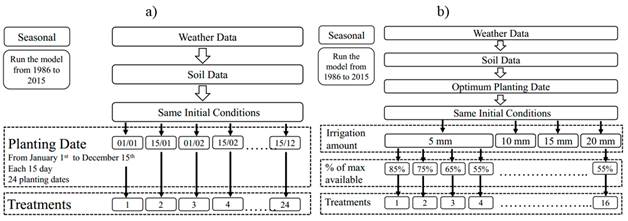
FIGURE 2 Methodologies to, a) obtaining the optimum planting date and b) evaluating irrigation strategies.
This virtual experiment is simulated consecutively from 1986 to 2015, being a total of 29 years based on the weather data that are included in the investigation. This methodology allows selecting which the best irrigation strategy is, having as criteria the yields, the total of water irrigated and the quantity of irrigations made.
Results and Discussion
Optimum Planting Date
Potential Conditions. After simulating the experiment in potential conditions, Jupiter variety, 24 variants of planting dates, with CROPGROP module of DSSAT, several results of great interest were identified. In Figure 3 it can be seen that the highest potential values were obtained for planting dates managed in January, where 100 % of the simulated yields are above 3000 kg/ha, with the highest value for this month around 6500 kg/ha. Between these values, those corresponding to the second of these dates, January 15, are distinguished, obtaining that all the simulated values are greater than 4200 kg/ha, 75 % between this level and 5600 kg/ha, and 25 % of the highest yields above 5600 kg/ha.
On the other hand, the lowest values vary from 1500 kg/ha to 2000 kg/ha and they correspond to the month of October. After this period, a clear growth in yields begins after November. With the exception of the dates at the beginning of the year, the results are permissible values in soybean crop once Romero et al. (2013), for Reddish Brown Fersialitic leached Soil, with the application of two irrigations per week and fertilization with complete formula at the time of sowing, obtained that, this variety, compared with other six, reaches the highest yields of 2110 kg/ha in sowing between November and March.
The cultivation of this oilseed is successful in climates with warm summers and optimum growth conditions at average temperatures from 20 oC to 30 oC (Rosas and Young, 1996), coinciding in this sense, with Díaz et al. (2007) that also stated that those closest to 30 ºC are ideal for developing this crop. The favorable yields of this variety in the month of January could be due to the fact that, temperatures had an average of 26.7 oC, which is optimal for the development of the crop. The same is not appreciated according to Figure 1, for the inherent months in intermediate planting dates.
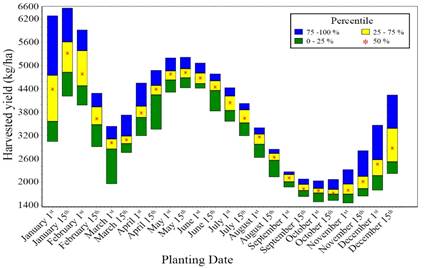
FIGURE 3 Behavior obtained from the potential yield in DSSAT for different planting dates of Jupiter variety soybeans
In the low yield of October, relatively low radiations and high temperatures are combined, because only during the month of October, a lower solar radiation in relation to the rest of the data series available was recorded. At the crop level, this lower radiation has consequences on the potential yield in this month. In this sense, according to Andrade et al. (2000), the flow of the incident radiation is decisive in the yield, as well as the one that is capable of being intercepted by the foliage.
Another important variable to consider are the days for the harvest, which have a high degree of variability in the month of January, with a minimum value of 125 days and a maximum value of 180 days, which does not agree with what is reported in the literature. According to Hernández et al. (2015), Jupiter variety of soybean has a cycle of 110 days, which is in correspondence with what was proposed by Romero et al. (2013).
For the aforementioned, in relation to the historical values of the weather variables, the weight of the soybean grains and their yields, January is the month where the potentials of the crop reached the highest values with respect to the rest. However, in this one, there is a high variability in the days for the harvest and their values are considerably high with respect to those referred in the literature, as a result this month can not be established as the optimum planting date. Taking into account the days for the harvest as a fundamental criterion, the optimum planting date for Jupiter soybean variety should be in the months of July and August for potential conditions.
Dry Farming Conditions. This simulated virtual experiment pursues the same previous purpose, but differs in terms of management, essentially in relation to the water supply to the crop. In this one, in particular, only the rainfall water and its influence on yields for similar planting dates were considered.
The yields that were previously higher in planting dates in January, in this experiment, where the historical daily rainfall for 29 years was taken into account, shows a significant decrease for this date, to the point of not exceeding 200 kg/ha as it can be seen in Figure 4. Something similar is observed for the sowing of the crop at the end of the year.
In this simulation the yield peak is located between April and June dates, coinciding with the period of greatest contributions of rainfall, which reaffirms what was proposed by Merino (2006) that, under Cuban conditions the cultivation of soybean presents a favorable productive development in spring sowing. On the other hand, Diaz (1979) indicated the periods from April to May, because it coincides with the beginning of the intense precipitations and the elevation of temperatures. However, Hernández et al. (2015) agree in pointing to July and August as the best ones because they obtained the highest yields in that stage. These results in soybean cultivation in dry farming, of course, are strongly dependent on the rainfall of each zone in particular.
In Figure 4, planting dates for the month of May stand out for their highest yields, especially May 15th, according to the analysis of percentile values. In spite of being within the months where the greatest number of precipitations accumulated, water insufficiency to supply the total demand of the crop produced reductions in the weight of the grains and in the yields with respect to the potential conditions.
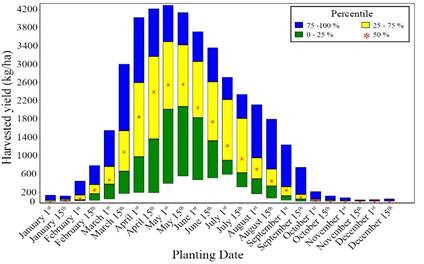
FIGURE 4 Performance of dry farming yield obtained by DSSAT for different planting dates of soybean Jupiter variety
On the other hand, it is very important to analyze the behavior of the days for the harvest. In the first months of the year, January and February, as well as in December, these values show a high variability and reach their maximum values up to 225 days on the date of January 15th. In addition, in March, there is a decrease in this parameter, reaching its minimum value in its 95 day in the first half of September. In the case of May15th., which is the date that stands out with the highest yields, harvest days vary from 150 to 160 days, which is much higher than the values found in the literature, which range around 110 days.
With the objective of achieving a compromise between the days for harvest and yield, the optimum date for sowing was chosen on July15th., the date on which harvest days are around 110 days, according to Hernández et al. (2015). In addition, in some years, yields of up to 2400 kg/ha are obtained, which is in accordance with some studies such as the one carried out by Romero et al. (2013). In addition, this planting date agrees with that recommended by Hernández et al. (2015).
Irrigation Strategies
After selecting the optimum planting date, the effect caused by different irrigation strategies on the yields on the selected planting date was studied. In Figure 5a the result of this process for different combinations of applied irrigation sheet and the percentage of field capacity it is shown. Yields vary from 500 kg/ha to 2900 kg/ha. It is also observed that the yield values have the same tendency depending on the water capacity available for the different amounts of irrigation applied. It is remarkable to note that for the same percentage of field capacity, the different amounts of applied irrigation, do not cause significant differences in yields, being their maximum values of 2820 kg/ha and 2920 kg/ha for 5 mm at 85 % and 20 mm to 85 %, respectively.
According to Hernández et al. (2015), soybean Jupiter variety is a summer clone and should be grown between the first 15 days of July and mid-August to achieve yields above 3800 kg/ha. That is not validated in this study, based on the result of the yields, which do not exceed this level in any of the treatments. However, other studies report yields around 2000 kg/ha (Romero et al., 2013; Hernández et al., 2015).
In order to guarantee the most favorable yields, it is considered appropriate to start the irrigation at 85 % of water available from the field capacity. In this way, it is obtained that the means of the yields in the 29 years of simulation are above 1800 kg/ha, regardless of the irrigation sheet applied. This coincides with what was proposed by Romero et al. (2013), where two irrigations per week are carried out with the objective that soil moisture conditions remain between 75 % and 80 % of field capacity.
In Figure 5b, the total amount of irrigation applied (mm) for each treatment is shown, and this is a parameter that depends significantly on the sheet applied in each irrigation, reaching values of 180 mm when watering 20 mm at 85 % of field capacity. It is very important in this study to make an efficient use of the water resource. When the means and the variances of the yields in the treatments are analyzed, in which 85 % of the field capacity is irrigated, it is obtained that these variables do not have significant variations, so the treatment that consumes less water (5 mm to 85 %) would be the most efficient.
However, another variable of great interest is the total number of risks during the life cycle of the crop. In this sense, the treatment (5 mm to 85 %) that consumes less water is the one that is irrigated the greatest amount of times, being its value more than twice in comparison with the next treatment (10 mm to 85 %), which generates other types of expenses that are also important. Considering that the yields do not vary significantly and maintaining a balance between water consumption and the number of irrigations, it can be said that the strategy that applies a 10 mm sheet to 85 % of the field capacity is the most appropriate. This strategy coincides with Hernández et al. (2015), in the total amount of irrigation accumulated. However, it applies approximately half of what it is recommended by Duarte et al. (2015).
Conclusions
Jupiter soybean variety, for both potential and dry farming conditions in the south of Mayabeque, has an optimal planting date in July 15th, whose cultivation cycle is around 110 days with yields of up to 4,600 and 2,300 kg/ha.
For the different irrigation strategies, there are no significant differences in yields depending on the total amount of water applied. In contrast, yields depend on the percentage of water set as the limit for the initiation of irrigation.
The irrigation strategy that applies 10 mm to 85 % of the field capacity is the most appropriate variant considering the yields and the balance between the total water applied, crop demand and quantity of irrigation.













